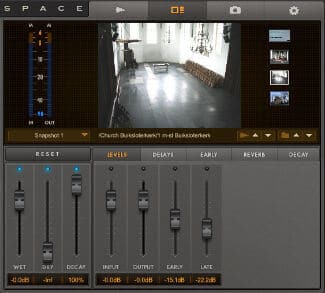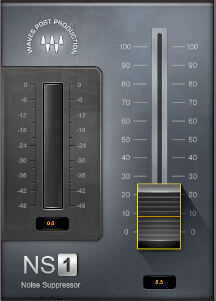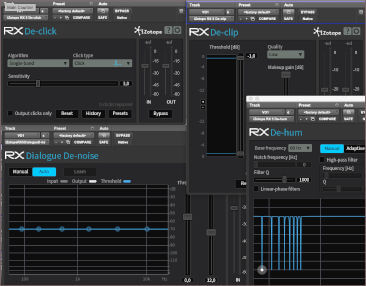Mixing audio for video – Other processing
When ‘polishing’ a voice-over recording, an EQ and compressor are the most commonly used tools. But there are many more tools to process the voice-over. Here are a few of these tools.
Noise-gates and expanders:
Can be very useful tools when mixing audio for video. Check out the tutorial ‘Noise-gates and expanders explained‘ for more information.

Reverb
Reverb occurs when a sound is reflected. You first hear the direct sound, but this also bounces off a wall and then arrives at your ear just a little later. And another part of the sound bounces of a wall first, then a ceiling, then a chair and only then arrives at your ear. All these reflections add up and are the reason we hear that tail to the sound that slowly fades away. The bigger the building, the more reflections and the longer it takes for the last reflections to reach your ear. So this gives a longer reverberation.
For voice-overs I hardly ever use reverb. I usually want the voice-over to be as direct as possible and to sound as close to the listener as possible. Reverb can quickly make it sound more distant.
But now I’m going to contradict myself right away. And I am going to talk about ‘3D mixing’. With that I mean creating the impression that in a mix some things sound right in front of you, and some things sound farther away from you. With reverb you can also create the impression that something is ‘up-front’ in the mix.
You do this with the pre-delay. Between the direct sound and the first reflection of the reverb is often a little bit of time, the pre-delay. If someone stands close to you and says something, the pre-delay is often a bit longer. That is because the direct sound reaches you almost instantly. But it will take that first reflection some time to get to you. If someone is a little farther away, it takes longer before the direct sound reaches you.
The first reflection may be close to that direct sound. Then the pre-delay is shorter. Sometimes the direct sound is almost completely covered by the reflections, because they both reach the ear at about the same time. Unconsciously we use that information to determine whether something is near or far. So a somewhat longer pre-delay and a subtle reverb can give the impression that something is close by. A short pre-delay and maybe a little more reverb can give the impression that something is farther away. Always in combination with other things, of course: if something is softer, it also seems farther away. Combine that with attenuating the mid and high frequencies just a little and you fool your brain even more that the sound source is far away, because high frequencies can’t move that far through the air. All valuable information if you want to mix in ‘3D’. So experiment with this!
De-Noisers:
If there is hiss in the recording, something probably didn’t go quite right during the recording. Maybe the recording level was too low and brought up afterwards. If there is a lot of hiss, the best thing to do is to do the recording again and fix whatever was broken the first time. But for many reasons this is often not possible anymore. A de-noise plugin can reduce the hiss from your recording. Good plugins that are easy to control are the Waves NS-1 and the iZotope Dialogue De-Noise. The operation of the NS-1 couldn’t be simpler: 1 fader with which you determine how much noise has to be removed. But if you try to remove too much, you will also affect the rest of the recording and it may sound like a badly encoded MP3 file (check the audio below to hear what I mean). So you can’t get rid of too much noise. A rule of thumb: If the noise is almost as loud as the speech itself, it is actually impossible to remove it.

Too much noise reduction
De-Reverb:
Perhaps the most frequently asked ‘repair’ question from video editors that I get as an audio nerd: “My recording sounds very hollow. Can you fix it?”
The answer was (and always has been) “No, unfortunately not…”. Because that ‘hollow’ sound you hear is the reverberation of the room. If you put the microphone too far away from the speaker, you hear all the reflections of the sound in the room. And the farther away you move the microphone from the speaker, the louder those reflections sound relative to the direct sound. And that’s that ‘hollow’ thing you hear. The only solution is to put the microphone as close as possible to the speaker during recording. There’s not much you can do afterwards. Well, there is one company that tries to give us a tool to fix this: Izotope with their De-Reverb plugin. But it doesn’t always work that well and pretty often you end up with a recording that sounds like a badly encoded MP3 due to the de-reverb processing.
Other restoration plugins:
I’ve mentioned it a couple of times here on AudioKickstart.com: The iZotope RX bundle. See image below. Really a ‘must-have’ for any audio-for-video mixer. You can restore clipped audio with the De-Clipper. Clicks are easily removed with the de-clicker and a hum is gone in no-time with the De-Hum plugin. Also the De-Reverb and De-Noise plugins are in this bundle. But besides iZotope you also have other restoration plugins, for example from Waves, Sonnox and Cedar.

Exciters:
A tone consists of one fundamental frequency and several harmonics. Some harmonics sound warm and nice to the ear. Other harmonics do not. An exciter amplifies those nice harmonics. This can make your voice-over sound a lot fresher and more sparkling.
But there’s a catch. When your ears are used to those nice harmonics, that suddenly sounds like the new normal. And so you want to put in more of that good stuff. This heroin effect often doesn’t make your mix any better. Very subtle use of an exciter can sometimes work, but beware of that addictive effect.

